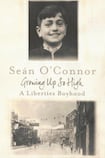
In the late 12th century Henry II came to Dublin with a guilty conscience. His friend Thomas a Becket, archbishop of Canterbury, had recently been murdered, and, as history tells us, the king had played his part in getting rid of this “troublesome priest”. To assuage his guilt Henry ordered the establishment of a monastery in the vicinity where now stands St Catherine’s Church, site of Robert Emmet’s execution. Henry’s gesture led to the creation of the Liberties of Dublin. It was also how Thomas Street, one of the city’s oldest thoroughfares, got its name.
Around the corner stands another of the city’s ancient routes, Francis Street, or “the independent republic of Francis Street”, as Seán O’Connor calls it in his absorbing memoir. This street became the Eden of his childhood, the place where he learned the importance of the parochial, in the 1940s and 1950s.
Today the area is perhaps more commonly known as the south inner city, but those of us who were born and grew up there were left in no doubt that we came from the Liberties and should be proud of the fact; proud too of the spirit of independence that has been a characteristic of its citizens since Henry’s charter of autonomy made it a place of special privilege, including sanctuary.
Those generations have long included O’Connor’s ancestors, on both his father’s and mother’s sides (his mother being an O’Neill), and Seán spent his childhood in the sheltering embrace of a devoted family – grandparents on each side of the street – and a wider community that left lasting impressions.
We first meet him setting out on an adventure to the far-flung acres of Crumlin to catch pinkeens – a “bazz off” out of his own territory. (O’Connor’s recall of local argot is one of the book’s pleasures.) The journey has its escapades: we are introduced to a war party from Dolphin’s Barn and a “common rossie”. In my memory “rossies” were to be avoided.
The book has many such instances of O’Connor’s relish for recounting in precise and entertaining detail the events, places and people of his Liberties boyhood. Family members, school and street companions, neighbours, characters (the name of local lawman Lugs Brannigan still terrified us a decade later ) are memorialised in his interweaving of a personal story with evocative communal scenes.
O’Connor’s tale is one of innocence and experience with perhaps more of the latter – the ever-curious boy is always willing to look and listen, alert to the wisdom of his elders and opportunities to learn. Rich in anecdote, incident and fond memory, his memoir brings to life a bygone era of ration books, cattle herded through the streets, farms down alleyways, dray horses on the cobbles, canal boats carrying turf from the Midlands and, above all, a place where community spirit prevailed in good and bad times.
He gives us the sights and smells – Woodbine smoke and Mansion polish – and the Liberties wit, an essential ingredient of the survival kit: a relative who offers him only a penny on First Communion day would put “two pound notes in a cage to breed”.
Budgies, chaffinches, linnets, wagtails all flit through these pages: birds and bird-watching are his passion. He even uses them to express a philosophical outlook: “I imagined that the intimacy of birds, and the warmth of their family life, must have a human equivalent, for which I had a covert aspiration . . . It also seemed clear to me that family life in the Liberties was founded on the same audacity: you needed only one day’s daring at a time.”
We may have reached the stage of memoir fatigue, but this is no misery-laced Angela's Ashes; nor has it the false notes of a Dublin in the rare aul' times. From the images of a smiling Shonny, as some relatives named him, on the cover to the shining moment of promise with which the book concludes, this is a joyous portrait of family life.
If there is an interlude of sadness and loss it comes in the author’s very moving account of the death of young brother Joe and the letter in which his mother contemplates her life.
And it was she who told him it was “better to be born lucky than rich”: his good fortune, and he seems to have had plenty of it, included encountering a genial and enlightened Christian Brother at “Franner”, his local school, who was keen to show his students “the way of the world by story and song”. Songs and music reverberate throughout his story – a kind of Liberties antidote to Liberties hardships.
The time frame in which O’Connor’s narrative takes place is sharply focused: it ends with his entry as a 14-year-old school-leaver into the world of work.
The author acknowledges the advice of his novelist son, Joseph O’Connor, to “allow the reader enter my little domain”. This he does with plain-spoken elegance, transporting the reader back to streets from which he took solace and inspiration but from which “the friendly bedlam of the Liberties was dying in a social upheaval” as the 1950s progressed.
Growing Up So High is a wonderful homage to the character of the Liberties and its people. Patrick Kavanagh declared, "I have lived in important places". So too has O'Connor, who, like the poet, knows the importance of such places in our formative years, as well as the value of our ancestral past.
Gerard Smyth is Poetry Editor. He grew up in The Liberties and is the author of eight books of poetry. He is also co-editor, with Pat Boran, of “If Ever You Go: A Map of Dublin in Verse and Song”, to be published by Dedalus Press early next year.











